March 19 update on COVID-19 in MN: Vaccinations rise; cases, hospitalizations up

Go Deeper.
Create an account or log in to save stories.
Like this?
Thanks for liking this story! We have added it to a list of your favorite stories.
3 things to know
24 percent of Minnesotans with at least one vaccine dose; officials expect big jump soon in vaccine supply
Outbreaks in Carver County, Mankato area and eastern Iron Range stir concern
Active cases top 10K for the first time since January; hospitalizations up
Updated 3:13 p.m.
State public health leaders on Friday implored people to stay vigilant against COVID-19, saying they were increasingly concerned about Minnesotans easing back as the weather warms and the vaccination picture brightens.
Officials have warned the highly contagious U.K. strain, now with a foothold in Minnesota, has the potential to spread throughout the state. There are more than 300 cases confirmed now.
Hots spots of new cases are bubbling in the southwest Twin Cities suburbs, in southern Minnesota around Mankato and in northern Minnesota on the eastern end of the Iron Range.
While the state’s made progress in vaccinations, especially among those age 65 and older, it hasn’t yet vaccinated enough people to establish a herd immunity, and there’s a danger of another surge.
Turn Up Your Support
MPR News helps you turn down the noise and build shared understanding. Turn up your support for this public resource and keep trusted journalism accessible to all.
“We are in a race between the variants and the vaccine, and the decisions we all make in the next few weeks will have a lot to say about the outcome of this race,” Kris Ehresmann, the state’s infectious disease director, told reporters. “We need to be cautious a little while longer.”
Active cases up; Carver Co., Iron Range hot spots
Minnesota’s COVID-19 numbers show disease conditions relatively stable compared to the late fall surge, but there are caution lights flashing.
There has been a noticeable rise recently in the count of known, active cases. Friday’s data shows 10,210 cases, marking eight consecutive days with active counts above 8,000, a stretch not seen since late January. It’s also the first time since late January that active cases pushed above 10,000.

While current counts are still low compared to late November and early December, the increase is notable given the concerns about the rise of the U.K. COVID-19 strain. Ehresmann said her agency suspects the U.K. variant is driving the current upswing.
Hospitalizations are still low compared to the late-fall surge, but those counts are also creeping up: 316 people were hospitalized as of Wednesday, with 74 needing intensive care.
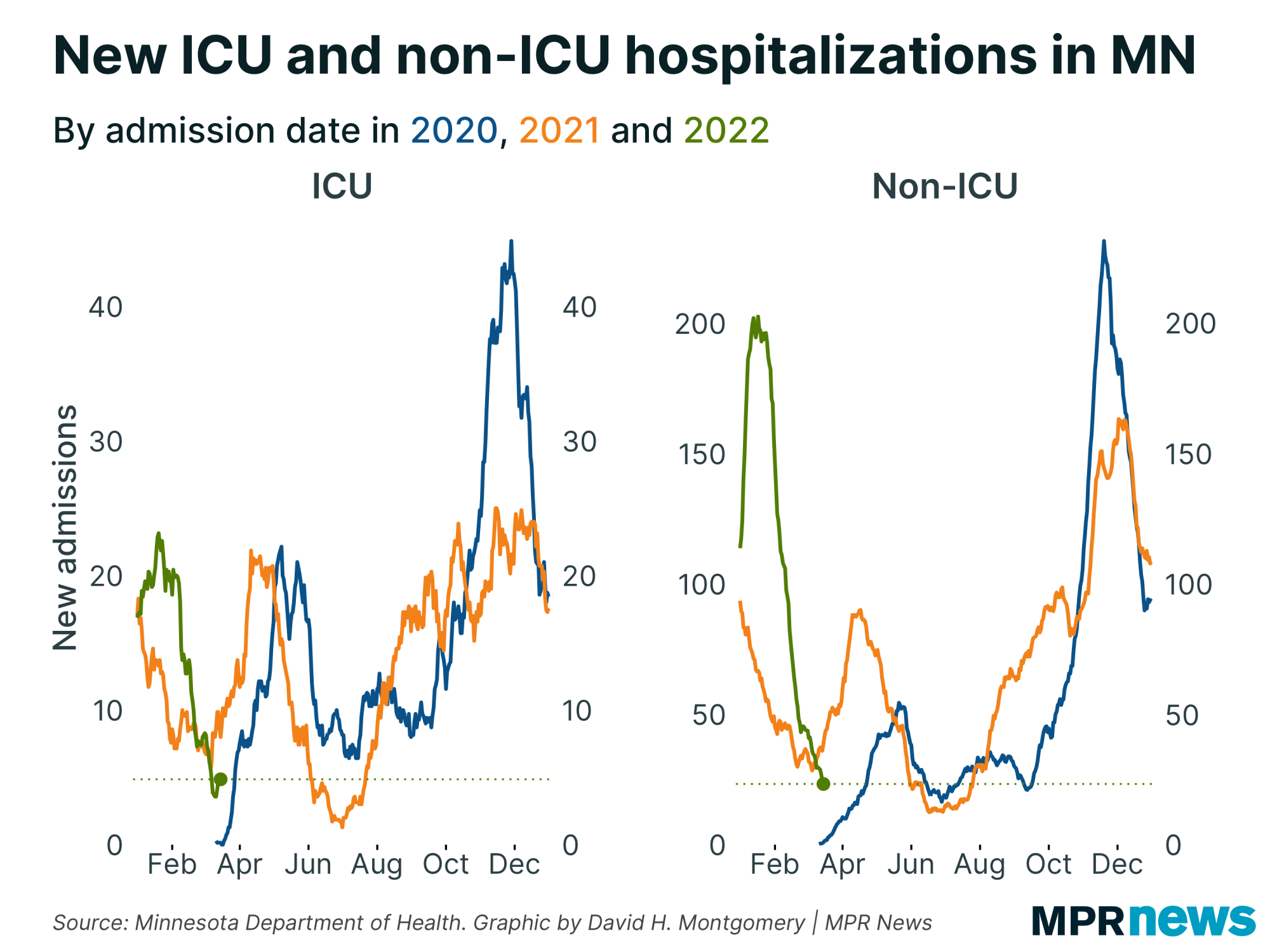
Nine newly reported deaths brought Minnesota’s collective toll to 6,771. Among those who’ve died, about 63 percent had been living in long-term care or assisted living facilities; most had underlying health problems.

The state has recorded 502,893 total confirmed or probable cases so far in the pandemic, including 1,449 posted Friday. About 97 percent of Minnesotans known to be infected with COVID-19 in the pandemic have recovered to the point where they no longer need to be isolated.

Public health leaders continue to keep close watch on a Carver County area outbreak tied to the U.K. strain and to youth sports.
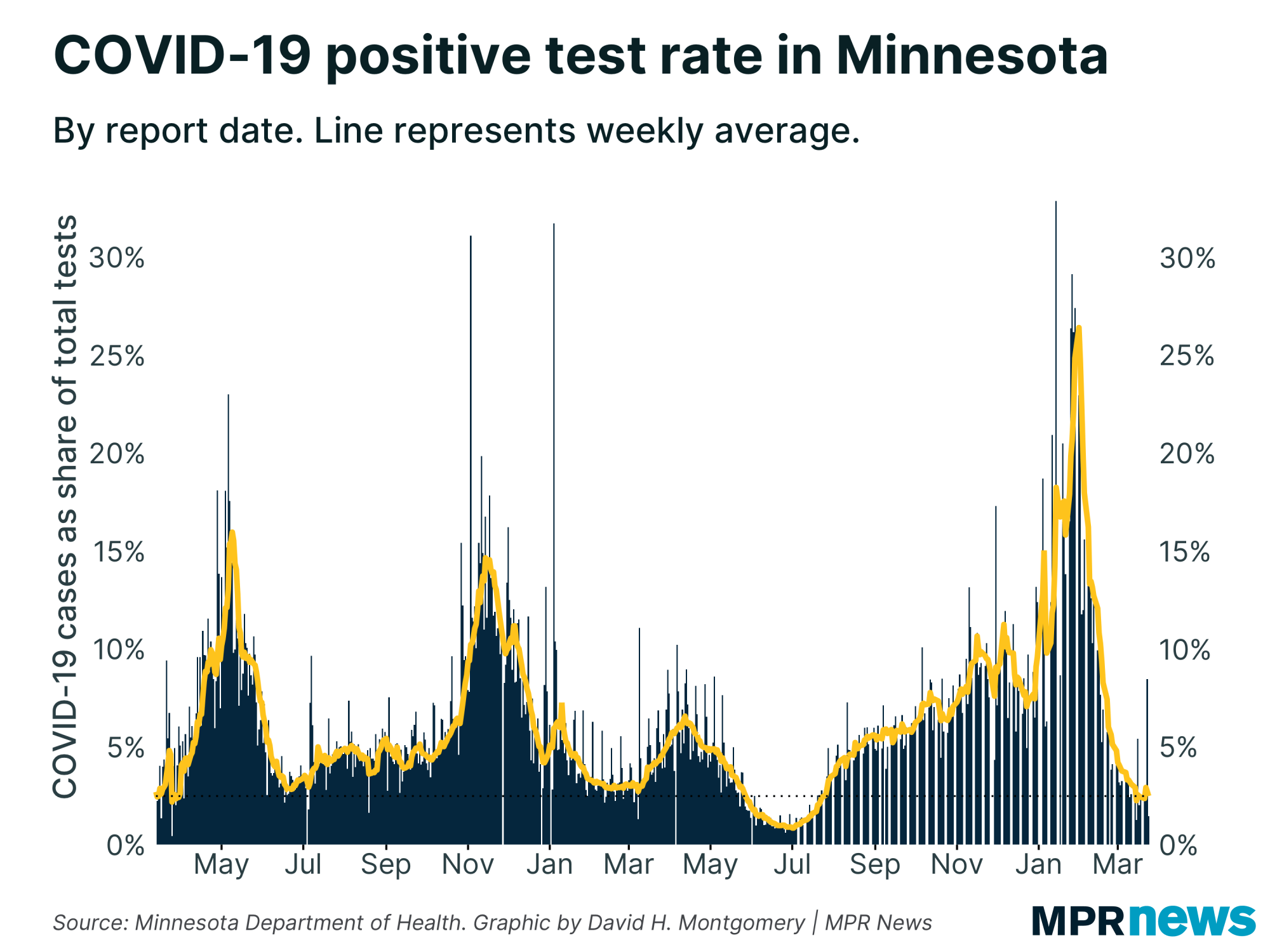
The state is recommending young people across the state be tested every two weeks for COVID-19, with student athletes tested weekly; officials are also asking everyone in Carver County to get tested.
The Health Department on Thursday also warned of “dramatic increases” in COVID-19 cases in the eastern end of Minnesota’s Iron Range centered around the town of Aurora. It didn’t say how many cases but officials will open a free testing site in Aurora on Monday and Tuesday.
Ehresmann also mentioned a hot spot now in and around Mankato.
As of Friday, there were some 317 cases of the U.K. variant confirmed statewide, she added. Twelve people have been hospitalized statewide from that strain; two have died.
Cases spread across age groups, regions
People in their 20s still make up the age bracket with the state’s largest number of confirmed cases — more than 94,000 since the pandemic began, including more than 49,000 among those ages 20 to 24.

The number of high school-age youth confirmed with the disease has also grown, with nearly 40,000 total cases among those ages 15 to 19 since the pandemic began.
With kids increasingly returning to school buildings and sports, Minnesota public health officials are urging Minnesota families with children to get tested every two weeks for COVID-19 now until the end of the school year.
Although young people are less likely to feel the worst effects of the disease and end up hospitalized, experts worry youth will spread it unknowingly to older relatives and members of other vulnerable populations.
People can have the coronavirus and spread COVID-19 when they don’t have symptoms.
Regionally, all parts of Minnesota are in significantly better shape than they were in late November and early December. Some areas are seeing upticks in cases.

While officials monitor the recent uptick in active cases, overall trends have improved to the point where Walz last week announced a rollback of many of the state’s remaining pandemic restrictions. “Normalcy is on the horizon,” the governor said.
But it’s not quite there yet. On Wednesday, Walz said that he, Lt. Gov. Peggy Flanagan and Health Commissioner Jan Malcolm were quarantining because of possible COVID-19 exposure.
Caseloads among people of color
In Minnesota and across the country, COVID-19 has hit communities of color disproportionately hard in both cases and deaths. That’s been especially true for Minnesotans of Hispanic descent for much of the pandemic.

Even as new case counts continue to track well below their late November, early December peaks, the data shows Latino people continue to be hit hard.
Distrust of the government, together with deeply rooted health and economic disparities, have hampered efforts to boost testing among communities of color, officials say, especially among unauthorized immigrants who fear their personal information may be used to deport them.
Walz has acknowledged that distrust by communities of color has been a problem during the pandemic. Officials have offered up some data on vaccinations broken down by race and ethnicity. The state is updating the data weekly.
Malcolm has said the state is committed to doing more to expand vaccine access to people of color, including getting more doses to community pharmacies, partnering with local groups and deploying mobile vaccination clinics.
Vaccination pace improves, but still flat
Friday’s vaccination data showed some promise after several days of lackluster data.
The Health Department reported 58,514 more vaccinations, significantly higher than last Friday. The seven-day trend is now running at nearly 41,000 shots daily. The trend’s been mostly flat to declining recently. That’s not necessarily bad since vaccine supplies are expected to jump soon.
Case counts and hospitalizations, however, are starting to slowly rise again and new hot spots are bubbling, reinforcing the belief that Minnesota’s in a race now to vaccinate people quickly enough to avoid another statewide COVID-19 surge.
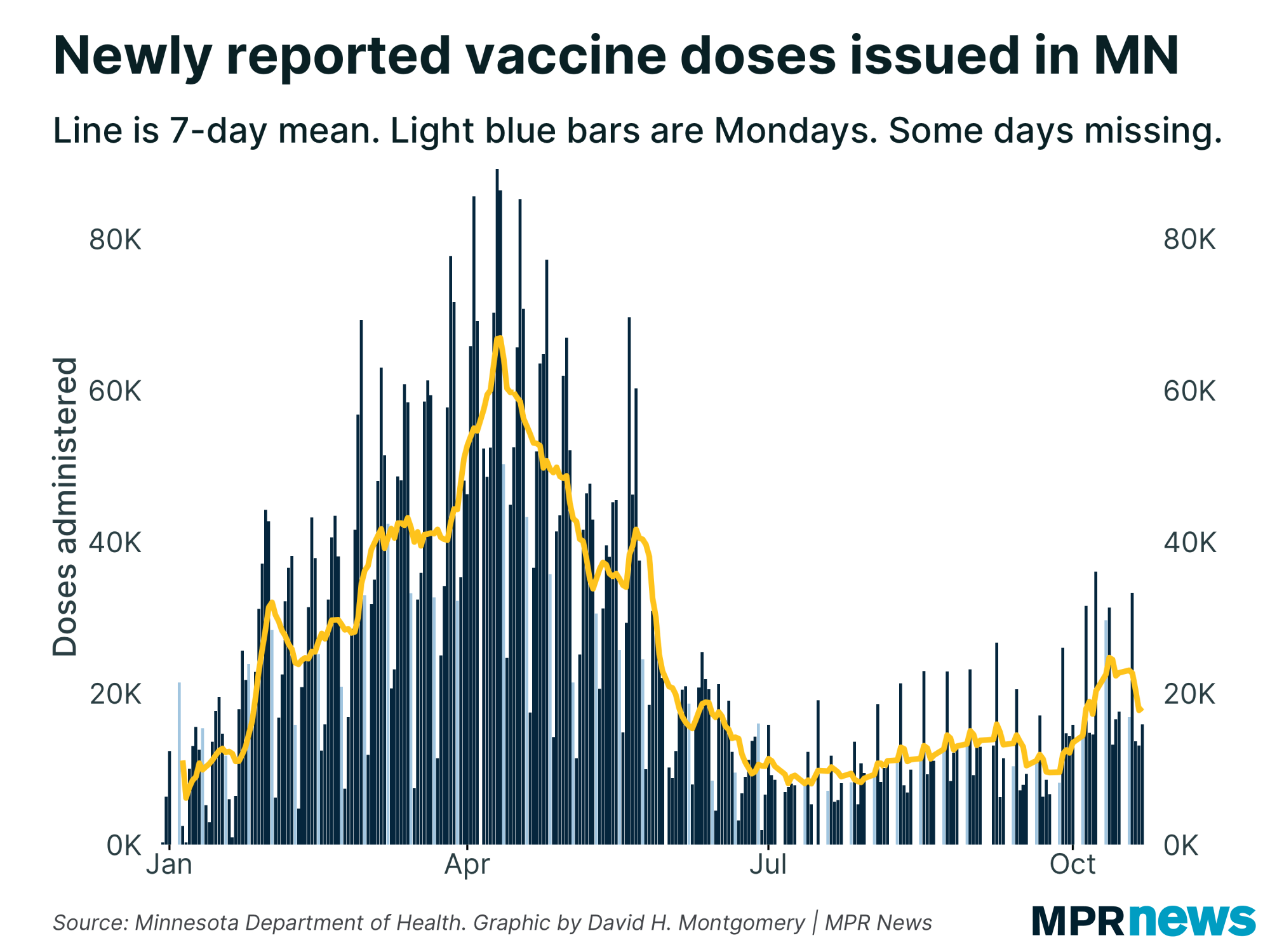
More than 788,000 people — about 14.2 percent of the state’s population — have completed their vaccinations, while more than 1.3 million — 24 percent — have received at least one dose, including nearly 78 percent of people age 65 and older.
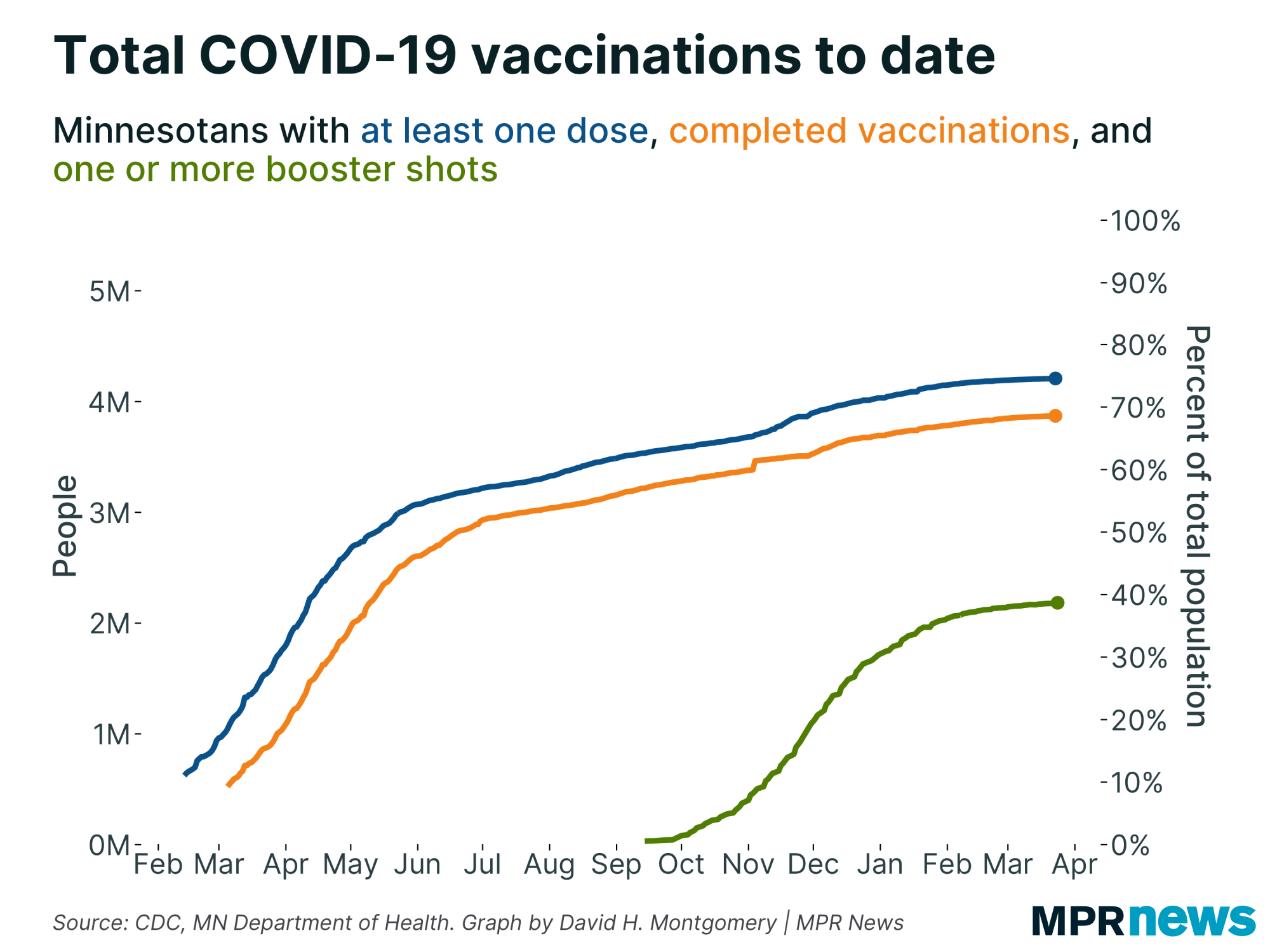
Minnesota anticipates getting 350,000 doses the week of March 29, Gov. Tim Walz said Friday. Starting in April, officials also expect the feds to deliver 100,000 doses a week of the Johnson & Johnson vaccine, which requires only one dose.
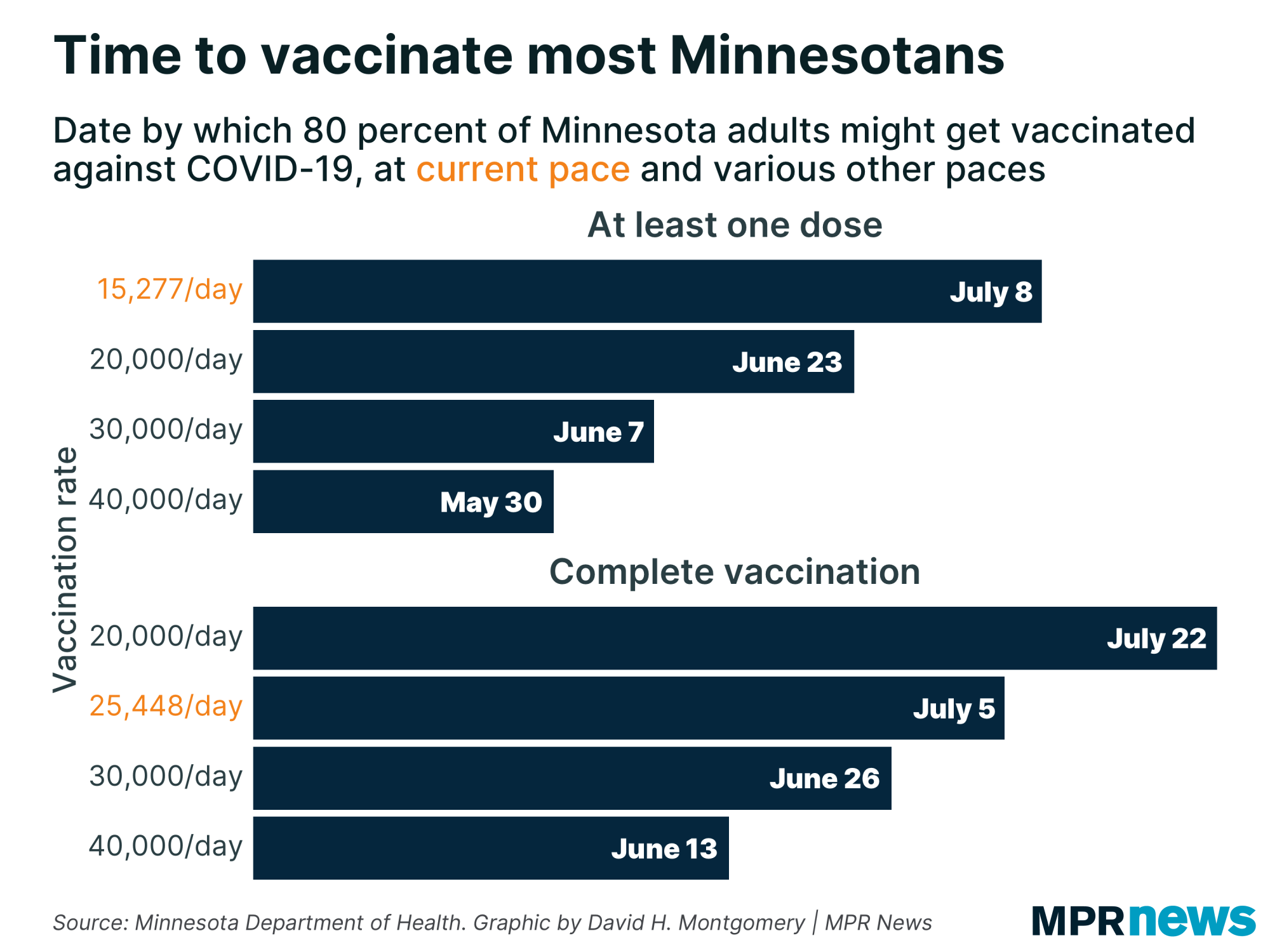
COVID-19 in Minnesota
Data in these graphs are based on the Minnesota Department of Health's cumulative totals released at 11 a.m. daily. You can find more detailed statistics on COVID-19 at the Health Department website.
Latest developments
North Dakota to expand vaccination pool to general public this month
North Dakota health officials say that vaccinations for the coronavirus will be available to the general public beginning March 29.
The state says some regions of the state could move into the Phase 2 vaccination phase even sooner. Health care workers, long-term care residents and staff, and older adults were the first to be vaccinated.
The state’s Health Department said as of Friday, almost 195,000 people in North Dakota had received at least one dose of the COVID-19 vaccine. There were 119 new cases of the coronavirus reported Friday, and one new death.
— The Associated Press
Top headlines
4 questions to help sort through the ethics of getting a COVID vaccine before you’re eligible: People are sometimes finding themselves in situations that might allow them to jump the line. What questions should you consider, according to an ethicist, if you find yourself in a similar circumstance?
Some MN businesses offer incentives for vaccinations: In an effort to speed up recovery from the pandemic, some Minnesota business owners are offering cash incentives for COVID-19 vaccinations. And they're not just going to employees — some are rewarding customers who get vaccinated, too.
Walz, Flanagan to quarantine after possible COVID exposure: The governor’s office says he tested negative on Monday but that he, Lt. Gov. Peggy Flanagan and Minnesota Health Commissioner Jan Malcolm will quarantine through March 25 given the possible exposure.


